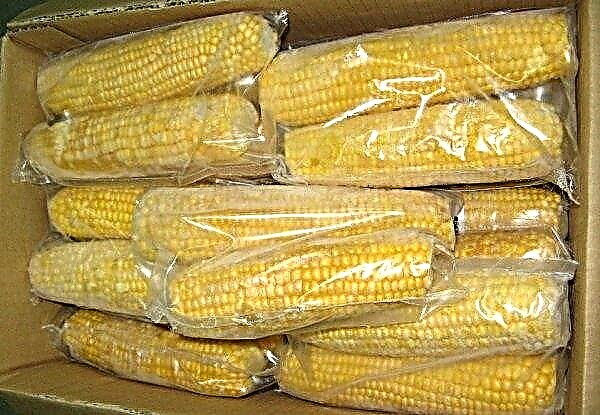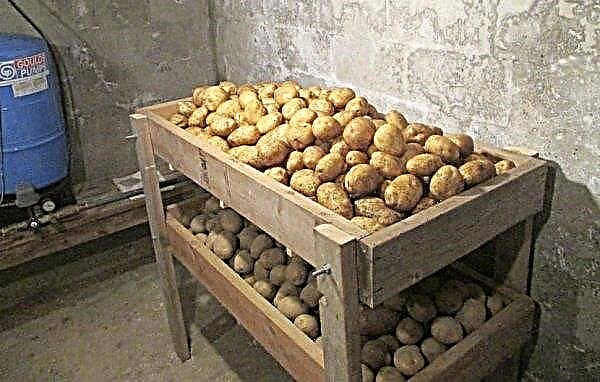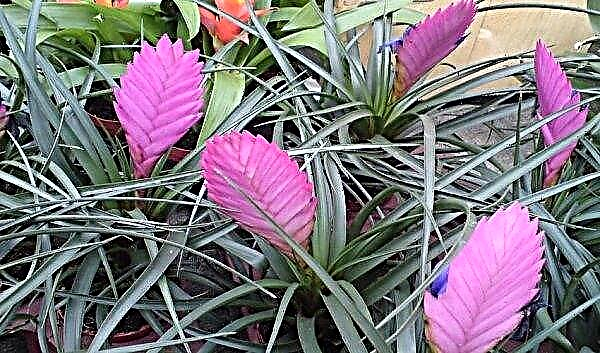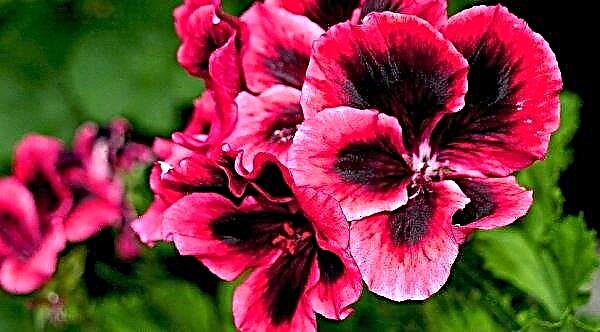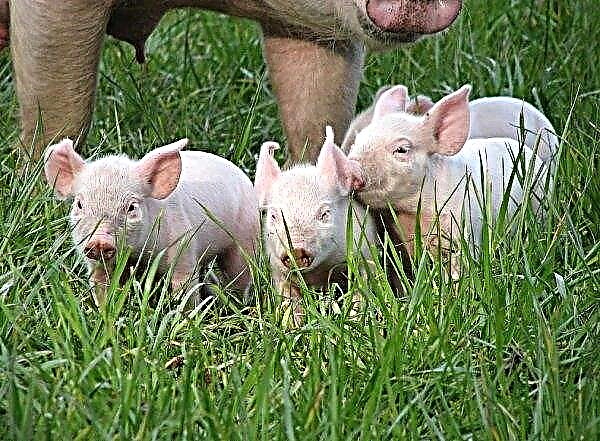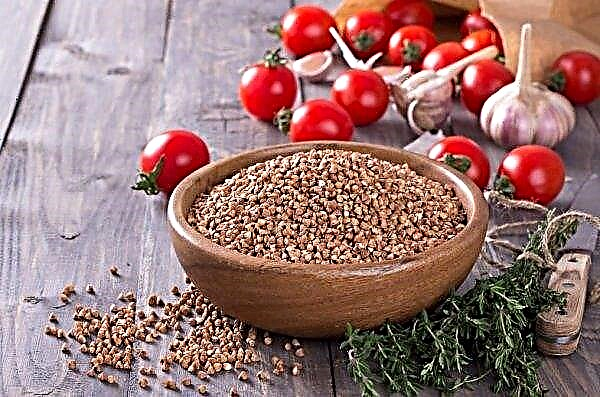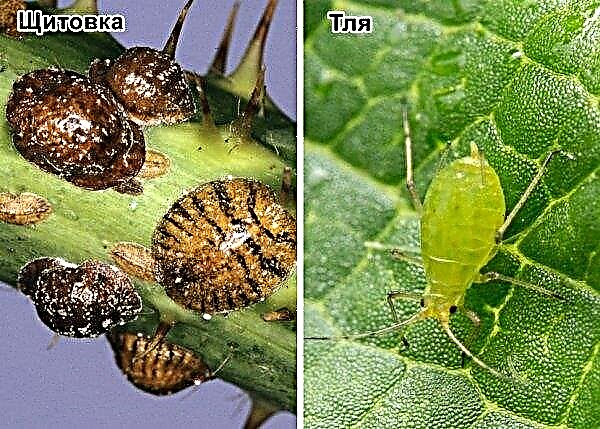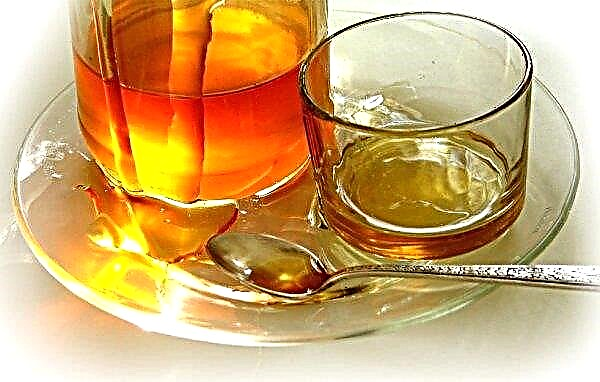Many varieties of thuja are excellent decorative elements in decorating a variety of private or public areas, which is largely due to their unpretentiousness to growing conditions and the versatility of various forms. This article will focus on one of the most popular varieties of the dwarf variety of these plants - the western thuja Golden Globe (Golden Globe), which is not in vain appreciated by many gardeners. What exactly it is remarkable for and what you should know about the features of planting and further care of the plant - read on.
Grade description
Golden Glob is represented by evergreen, slowly growing shrubs with a yellowish tinge of needles. Despite the fact that its maximum height is 1.2 m, a ten-year-old plant grows only up to 80 cm, while maintaining the same values for the diameter of the crown.
The compact parameters and small annual growth (about 8-10 cm) allow you to plant thuja anywhere, regardless of the area of the plot, which is very valuable in landscape design. Not the last advantage are the features of the color of the needles of the plant. With a green base, it has golden yellow tips, which makes the plant appear copper in the fall and gold in the beginning of summer, standing out against the backdrop of classic greenery.
Did you know? Thuja Golden Globe was obtained as a result of a mutation of a thuja of the Woodwardii variety with a yellow color of needles. On the territory of Europe, and then Russia, appeared in 1963, after it was exported from the United States by F. Grothendorst.
Bark - brown or red-brown, exfoliates in narrow stripes. The root system is superficially located, but it has several deep roots that draw moisture and nutrients from the deep layers of the soil. If desired, thuja Golden Glob can be grown in a container way, placing pots on both terraces or balconies, and in the halls of houses.
In landscape design
Spherical thuja with a golden tint of needles could not go unnoticed by landscape designersTherefore, today it can be found both in the role of a tapeworm for a small lawn, and as a constituent element of hedges, flower arrangements, and even as a houseplant grown in pots.
Single landing
Single landings using the Golden Globe thuja will be appropriate for a limited space area or in cases where you need to focus on a specific area, for example, the corner of the site, next to the gazebo. In addition, several separately planted plants can form an integral composition, if you look at them from a certain point (for example, from the balcony or terrace of a house), which also favorably distinguishes the homestead territory from the neighboring ones. The general requirements for the placement and the landing process itself when organizing single landings of thujas do not have any features.
Live borders
Living fencing is always very original and unusual, and if we are talking about the spherical components of such a fence, then it certainly will not go unnoticed. The low "growth" of the described arborvitae does not allow using it as a high fence, but it’s quite realistic to create small borders around the flowerbed or arbor. Also with the help of the Golden Globe thuja, you can organize a frame of dry streams or plant plants on the border with neighbors along the fence, which will also be an excellent decorative solution.
Songs
When planting a thuja in a composition, one can consider the option of combining with flowers, as well as combining a plant with other coniferous or even deciduous crops, as well as climbing plants and flowers, moreover, it is desirable that some of them be tall. Such compositions can be placed both in the central part of the site, and next to streams, arbors or other structures in remote parts of the territory.
Important! Thujas tend to inhibit the growth of other plants in the area, in particular, decorative roses. Therefore, slow-growing types of flowers should not be placed next to coniferous stands, replacing them with more suitable meadow and mountain varieties of flowers.
In pots
With the right selection of containers for the cultivation of arborvitae, they will delight the gardener with their decorativeness no less than when grown in the open, and an additional advantage will be the opportunity to design not only the facade of the house, but also the space on balconies, terraces or even interior spacious rooms, such as an entrance hall.
In all these cases, it is possible to place plants both individually and to create whole compositions from them, arranging the pots in a certain sequence. The main requirement for this method of growing crops is to provide plants with regular watering and top dressing.
How to plant
Planting of any kind of thuja begins with the selection of a suitable young plant for this plant and the organization of the optimal seat, after which the planting activities themselves are carried out. Each of the actions has its own characteristics, which are always worth remembering.
Seedling Selection
To protect yourself from disappointments in the future, you should buy Golden Globe thuja only in specialized stores or nurseries that guarantee the quality of their products.
A personal inspection of the selected plant should pay attention to the following features of a quality seedling:
- moderately elongated crown (in seedlings of this variety, it should resemble a ball, not an oval);
- natural, uniform color of needles, without dry fragments in separate areas;
- a trunk that is strong and healthy in appearance (there should not be any bulges, soft patches or deep cracks in the cortex, since any of them may indicate the development of diseases or the presence of thuja pests);
- dry and clean roots (if the seedling is not sold with a closed root system, make sure that there are no traces of mold or rot on the roots).

A large earthen lump does not always indicate a well-developed and strong root system of the plant, it is likely that the rhizome was simply schooling (artificially formed), and therefore can not fully cope with the functions assigned to it to feed the plant in the future.
Site and ground preparation
Thuja Golden Globe grows well and develops in spacious, well-lit areas of the sun, sheltered from sharp gusts of cold winds. The composition of the soil can be almost any, the main thing is that its acidity values are close to neutral values (pH level in the range of 4.5–6). Landing on alkaline soils is permissible, but acidified areas are best avoided.
If the territory is predominantly heavy clay or loamy soils, then in the organized planting hole you first need to lay out a drainage layer (10-15 cm thick), and then fill the nutrient mixture on the basis of a fertile substrate from the planting site, peat and sand, combined in a proportion of 2: 1: 1.
Important! Despite the fact that thujas and firs belong to the same group of “conifers”, they are not worth planting next to them, since the Golden Globe variety is not sufficiently tall and the spruce will obscure it, thereby halting normal development.
For a good growth of the root system of the culture, it must be in loose soil, preferably enriched with nitroammophos or a specialized complex of mineral fertilizers for conifers, which are also introduced into the landing pit during planting (consumption rates and fertilizer method are always marked on the package with the drug).
Step-by-step instruction
Planting of the selected seedlings of the described arborvitae begins with the organization of a planting hole measuring approximately 60 × 80 cm or a hole that is 15–20 cm larger than the parameters of the root system of the acquired young plant.
After arranging the drainage layer and filling the hole with the prepared nutrient mixture (from local soil, peat and sand) to 1/3 of its volume, the following actions should be performed:
- Place the container with the thuja in a large container filled with water and wait until the soil with an overgrown root system of the seedling separates slightly from the wall of the transport box.
- Remove thaw from the pot and move it into the prepared hole, gently straightening the roots over the entire surface (the root neck should not deepen into the substrate, it is always left above the ground).
- Fill the free space in the pit with the remaining soil mixture and ram it around the trunk, thereby forming a trunk circle.
- Water the plant abundantly, pouring at least 10-15 liters of water at a distance of 20 cm from the trunk.
- Mulch the near-stem zone with a layer of peat or sawdust, which will help maintain moisture in the ground for a long time and prevent the growth of weed grass.

At this, the thuja planting can be considered completed and all further actions during its cultivation will be associated only with the care of the crop.
Further care
So that Golden Globe thuja varieties always remain beautiful and delight the gardener with their appearance, plants need to provide the appropriate conditions for this, which are always based on several basic actions: timely watering, top dressing, pruning and shaping bushes. In addition, prevention and timely treatment of diseases will be an equally important task, and in the cold season also the organization of shelter for young seedlings.
Did you know? In ancient times, Native Americans used thuja leaves as an anesthetic for headaches, as well as a good preventive solution in the fight against scurvy. Different parts of this plant are rich in vitamin C, which served as the basis for such a treatment.
Trimming and Shaping
Golden Glob coniferous bush grows on average about 20 years and during this time does not require frequent pruning, maintaining its spherical shape even without them. Most gardeners perform only sanitary removal of broken, shrunken, damaged and improperly growing branches, planning the procedure in early spring. When shortening or completely removing branches, it is important to use only a sharp tool, being careful not to cut branches with sleeping buds.

If necessary, in the summer, you can slightly shorten the ends of the individual branches protruding from the "ball" (sometimes half or one third of the length of shoots grown in the spring is removed). As a result of this procedure, the golden color of the crown may slightly change, as the branches begin to turn yellow in the upper part, however, the growth of new shoots occurs relatively quickly, so you should not worry about it.
Watering and feeding
This Golden Globe is deservedly considered a moisture-loving culture, but still you should not allow stagnation of moisture near its root system. In the first year of cultivation, the optimal irrigation frequency is considered 1 time in 7 days, with an increase in regularity only in the dry summer period (up to 1 time in 3-4 days). For one irrigation per bush, you need to use at least 10-15 liters of liquid, and on especially hot days - up to 20 liters of water protected and heated by the sun. In the evening, it is useful to spray the thuja crown, washing away the dirt and moistening the needles from above. When the ornamental plant dries, fruits will begin to form on it, worsening the appearance.
As far as nutrients are concerned, only complex mineral formulations for conifers will be a suitable option. If they were already used during planting, then the next time you can fertilize the plant only after 2 years of cultivation, planning to perform work in the spring. It is better not to fertilize the thawed organics (especially fresh humus), but compost compositions can be decomposed in the autumn in the near-trunk zone as a mulching layer, so they will not be able to harm the roots of the conifer.
Diseases and their treatment
Despite the disease resistance of Golden Globe needles, one should not completely exclude the possibility of spreading fungi on the plant, as a result of which young shoots die and the bush can die completely. Therefore, at the first manifestations of the signs of rot, it is worth treating the thawed solution with copper sulfate, performing spraying in two passes with an interval of 14 days.
Among other effective fungicidal preparations for eliminating such a problem, one should give preference to “Topsin” and “KhOM”, preparing the working solution in accordance with the recommendations on the package.
Pests and the fight against them
If diseases do not affect the described plant, this does not mean that the bush cannot be affected by the invasion of individual pests. For example, if you notice dried areas on a plant, it is likely that a false shield settled on it, in the fight against which the spraying with the insecticide "Karbofos" will be effective, in the preparation of which 90 g of the substance is dissolved in a bucket of water. For preventive purposes, you can use a one percent solution of Bordeaux mixture.
The second "popular" pest of the Golden Globe thuja is the thuja aphid, colonizing shoots in whole colonies (insects can be found on the underside of branches). As a result of their vital activity, the tissues of the plant lose their juice, which is why they turn yellow and die. To prevent this, it is worth spraying the culture with any available insecticide from this pest, the most popular of which are today considered "Decis", "Fitoverm", "Karbofos". The working solution is prepared in accordance with the manufacturer's recommendations, and applied twice a season, with an interval between treatments of 7-8 days.
Winter preparations
Thuja Golden Globe is a frost-resistant plant and in most regions of Russia can be grown without shelter for the winter. However, this applies only to adult bushes, but young specimens planted this year can still freeze and require more thorough preparation.
For example, at the end of September or the beginning of next month, it is worth watering the plantations abundantly, pouring 40 liters of water under adult bushes, and about 25-30 liters of liquid under young bushes. As soon as moisture is absorbed, the near-trunk zone is mulched with a 15-cm layer of peat.
Moreover, in areas with snowy winters, it is better to tie up loose branches to the trunk (so that they do not break off under the weight of snow), after which cover the bushes with lapnik, burlap or any artificial material at your discretion. Only with a responsible approach to the planting and further cultivation of the Golden Globe thuja can we hope for its high decorative qualities and problem-free cultivation on the site.

